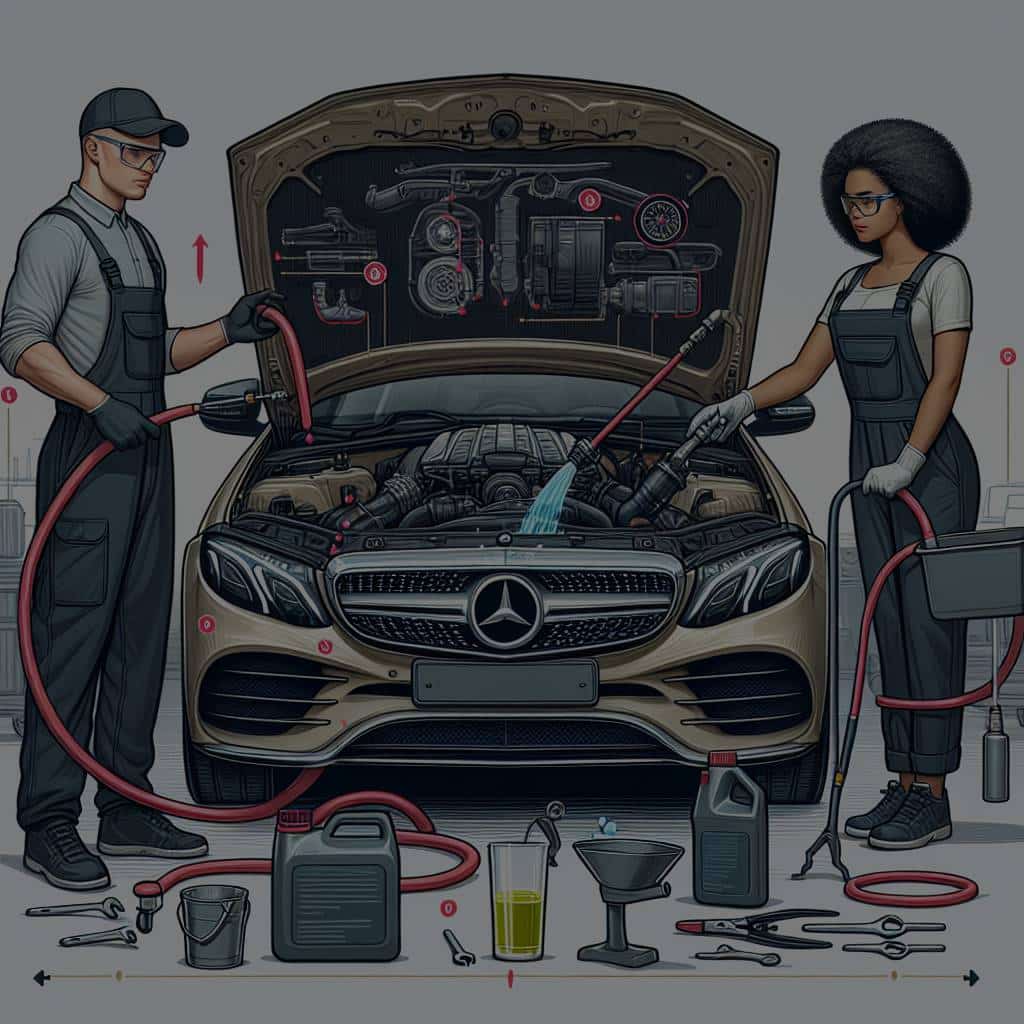How to Perform a Coolant Flush on a Mercedes-Benz E-Class?

Maintaining your Mercedes-Benz E-class vehicle requires more than just regular cleaning, oil changes, and tire rotations. One crucial aspect of car maintenance that often gets overlooked is the coolant flush. This process helps keep your engine running smoothly and efficiently by eliminating any debris or sediment that may have accumulated in your cooling system over time. In this article, we will guide you on how to perform a coolant flush on your Mercedes-Benz E-class vehicle.
Mercedes-Benz recommends a coolant flush every three years or 15,000 miles, whichever comes first. But remember that these are merely guidelines and the frequency can change based on driving habits and conditions.
This might interest you : Why choose an olla pot for your kitchen?
Why is a Coolant Flush Important?
Before we dive into the step-by-step process, it’s imperative to understand why a coolant flush is crucial for your Mercedes-Benz E-Class. The coolant plays a vital role in your car’s performance as it maintains the engine’s temperature, preventing it from overheating. Over time, the coolant can get contaminated, leading to poor cooling and, in extreme cases, engine damage.
A coolant flush doesn’t just involve draining out the old coolant. It also includes cleaning the entire cooling system, including the radiator and coolant reservoir, which can collect debris and sediment over time. By flushing the coolant, you will prolong the lifespan of these vital parts and ensure that your engine performs at its optimum level.
This might interest you : Discover personalized service with Croydon's best estate agents
Gather the Necessary Tools and Supplies
To perform a coolant flush, you will need a few essential tools and supplies. They include:
- A drain pan
- Distilled water
- New coolant (Mercedes-Benz recommends using only their brand of coolant)
- A funnel
- A wrench
Ensure you consult the service manual for your specific Mercedes-Benz E-class model to ascertain the correct type and quantity of coolant required.
Draining the Coolant
The first step in performing a coolant flush involves draining the old coolant from your vehicle. While the process may seem straightforward, it’s essential to follow certain precautions to ensure the procedure is carried out safely and efficiently.
Start by allowing your vehicle’s engine to cool down. It’s unsafe to drain the coolant while the engine is hot as hot coolant can cause severe burns. Once the engine has cooled down, locate the drain plug, usually found at the bottom of the radiator.
Place your drain pan underneath the drain plug, then use your wrench to loosen the plug. Allow the coolant to drain into the pan. Once the coolant has fully drained, tighten the drain plug back.
Flushing the System
After you’ve drained the old coolant, the next step involves flushing the cooling system. This process removes any residual coolant and debris from the system.
To do this, fill the radiator with distilled water, then start your engine and let it run until it reaches operating temperature. This helps circulate the water throughout the cooling system, dislodging any remaining debris. Once done, turn off the engine, let it cool down, then repeat the draining process.
Filling the System with New Coolant
Finally, after flushing the system, it’s time to fill it with new coolant. Using a funnel, slowly pour the new coolant into the radiator. Be sure to use the correct type and quantity of coolant as per your Mercedes-Benz E-class service manual.
Once you’ve filled the system, start your vehicle and let it run with the radiator cap off. This will help the coolant circulate throughout the system and will also help eliminate any air pockets. After a few minutes, check the coolant level and top off if necessary.
In performing a coolant flush, not only are you extending the lifespan of your Mercedes-Benz E-class, but you’re also ensuring its optimum performance. The process might seem complex, but with the right tools and a little bit of patience, you can do it yourself, saving both time and money. However, if you’re uncertain or uncomfortable performing a coolant flush, it’s always best to consult with a professional. Remember, routine maintenance is key to keeping your vehicle in top shape, and a coolant flush is a significant part of that routine, ensuring your Mercedes keeps its cool on the road.
Safety Measures and Potential Issues
Before you begin the coolant flush process on your Mercedes-Benz E-Class, it’s important to maintain proper safety measures. Always remember to wear protective gloves and safety glasses while performing a coolant flush, as the coolant is a hazardous substance.
Ensure that the engine is completely cooled down before you start the flushing process. Opening the coolant reservoir or radiator cap while the engine is hot can lead to a release of pressurized steam or hot coolant, which can cause severe burns.
Moreover, it’s crucial to properly dispose of the old coolant. Coolant is toxic and can be harmful to animals and the environment. Thus, it should be disposed of at a designated recycling facility or auto parts store which accepts used coolant.
While draining the coolant, take extra care to ensure the drain plug is tightened correctly after draining. If the drain plug is not secured properly, it can lead to coolant leaks, resulting in engine overheating.
In some cases, the coolant in your Mercedes-Benz E-Class may appear rusty or have a strange smell, or you may notice deposits or debris floating in it. These are indications that your coolant is contaminated and needs to be changed promptly. Ignoring these signs can lead to potential engine damage.
Routine Coolant Maintenance for Your Mercedes-Benz E-Class
A coolant flush is an excellent way to maintain the health and longevity of your Mercedes-Benz E-Class engine. However, it is not the only preventive measure to consider. Regularly check the coolant level in your vehicle, especially before long trips. If you find the coolant level frequently low, it may indicate a leak in your cooling system, which should be inspected by a professional.
It is also advisable to inspect the condition of your coolant regularly. If you find it contaminated, it’s time for a coolant flush irrespective of the miles driven or the time since the last flush.
Consider scheduling regular maintenance checks with a professional, such as the knowledgeable Pelican Staff. Their experience with Mercedes-Benz vehicles ensures that your E-Class is in safe hands.
Conclusion
Performing a coolant flush on your Mercedes-Benz E-Class is not as daunting as it may seem. With the right tools, patience, and adherence to the steps outlined above, you can successfully carry out this maintenance task.
Routine coolant maintenance is vital for your Mercedes-Benz E-Class. It ensures the engine runs smoothly, preventing overheating and possible engine damage. Besides, it enhances the performance and extends the lifespan of your vehicle.
Remember, if you’re unsure or uncomfortable performing a coolant flush, don’t hesitate to consult a professional. It’s always better to be safe than sorry when it comes to maintaining your vehicle. After all, a well-maintained Mercedes-Benz E-Class is not only a joy to drive but also a testament to your good driving habits and care for your vehicle.
So, whether you’re a DIY enthusiast or prefer professional servicing, don’t ignore the importance of a regular coolant flush for your Mercedes-Benz E-Class. Your vehicle will thank you for it, and you’ll enjoy those smooth drives even more.
